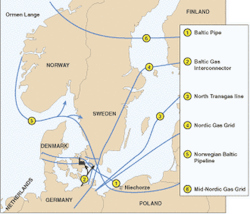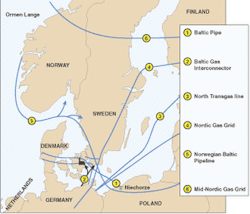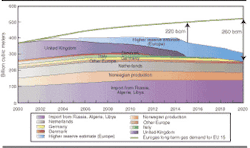Pipeline network emerging across Scandinavia and Eastern Europe
In addition to the platform design work for DONG in the Nini/Cecilie project, Ramb ll has served as a consultant for several other northerly gas transmission studies, including North Transgas, commissioned by Fortum and Gazprom in 1999-2000. This involves a potential large diameter pipeline taking gas from the Yamal peninsula and Shtokmanovskoye fields in the Russian Barents Sea to northern Germany, via southern Finland. Kværner Zeetech in Zoetermeer, The Netherlands, was subcontracted by Ramb ll for engineering of the pipeline route.
"The proposed offshore section across the Baltic Sea looks difficult for pipelaying, but not impossible," says Ramb ll Project Director Ole Frank Jorgensen. "There is a deep depression in the north of the sea, in 470 m of water, but the general depth is closer to 80-100 m. We looked at potential landfalls in Russia, Sweden, and eastern Germany, including Rostock and Lubeck. This project is still very much alive. Ruhrgas is known to consider taking a minority stake in North Transgas, seeing it as a viable alternative to overland lines traversing countries such as Belorussia." Russia's President Putin is also thought to favor a route through the Baltic.
Jorgensen was also project manager for the Baltic Gas Interconnector, another ongoing scheme driven by Sweden's Sydgas, Denmark's Energi E2, and Germany's Verbundnetz Gas. Here the plan is to take gas from central Europe in a criss-crossing, onshore/offshore route taking in Rostock, Trelleborg in Sweden, and Copenhagen. It could also be linked at some point to the BalticPipe.
Another proposal tabled last year was a Norway-Poland system (Norwegian Baltic Pipeline) taking gas from the North Sea 1,000 km to Poland, en route perhaps tracking the southwest Norwegian and northwest Swedish coasts. Around 74 bcm would be exported over 16 years, starting in 2008, although Statoil has since said that this would be insufficient to justify the cost of the new line. Here too, there could be an interface with the BalticPipe.
The newest transportation project under discussion is the Mid-Nordic Gas Pipeline, which would draw supplies from the giant undeveloped Ormen Lange field and others off mid-Norway. The route would take in Skogn on the Norwegian coast, heading eastward overland via Ostersund and Sundsvall in Sweden, from where it would then cross the Gulf of Bothnia to its main targeted customers - power plants on Finland's west coast currently fired by coal. To ensure security of supply, there could be parallel lines over the offshore section, in case one should rupture en route.
Capex for this project is estimated at weird950 million, including construction of a new offshore pipeline in the Norwegian Sea and upgrades to the existing Tjeldbergodden-Skogn offshore line. A spur line could also be put in to Stockholm at the eastern Swedish end. The main technical challenge for the pipelay could be the rocky coastlines and rocky outcrops in the Gulf of Bothnia.
"Sweden is very much the dark horse in some of these projects," says Jorgensen. "It depends how their energy plans develop over the next decade, particularly as they are due to close two of their nuclear plants."


